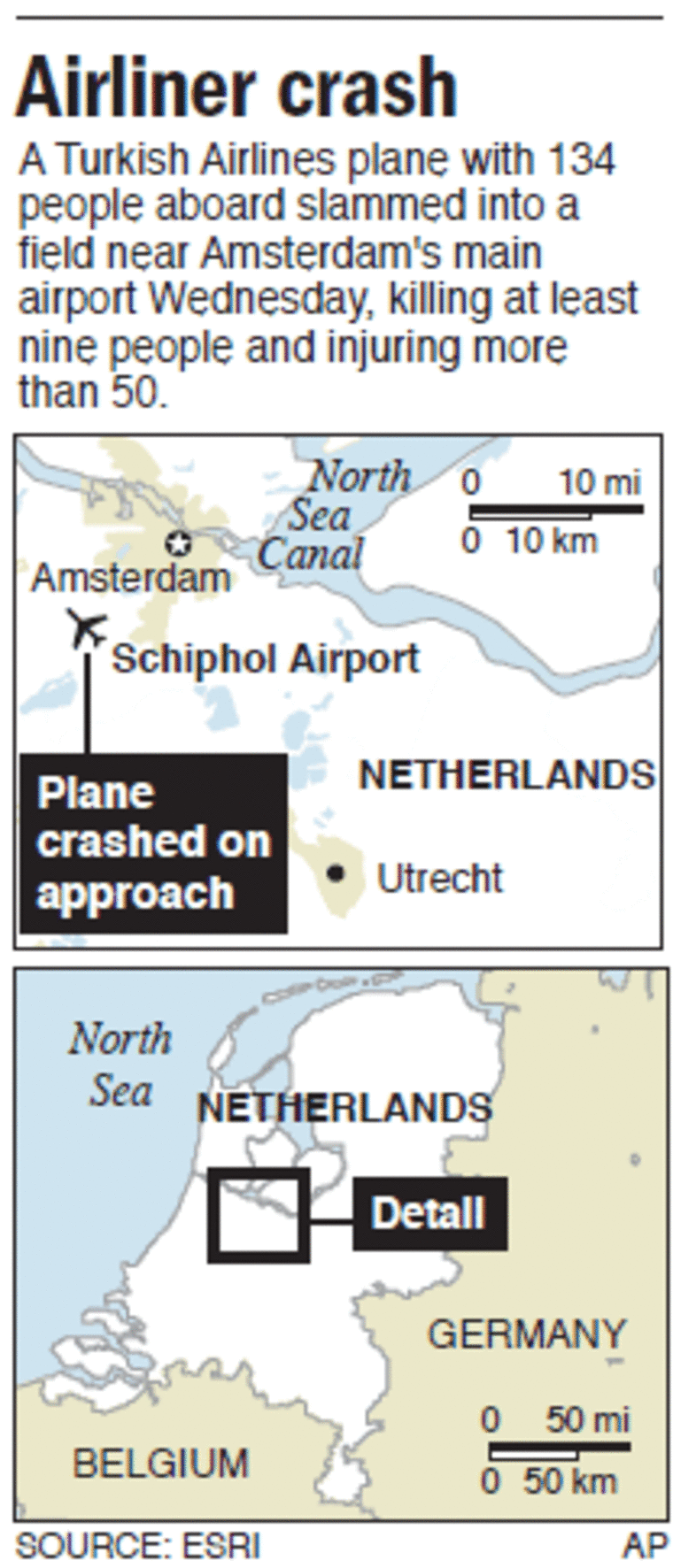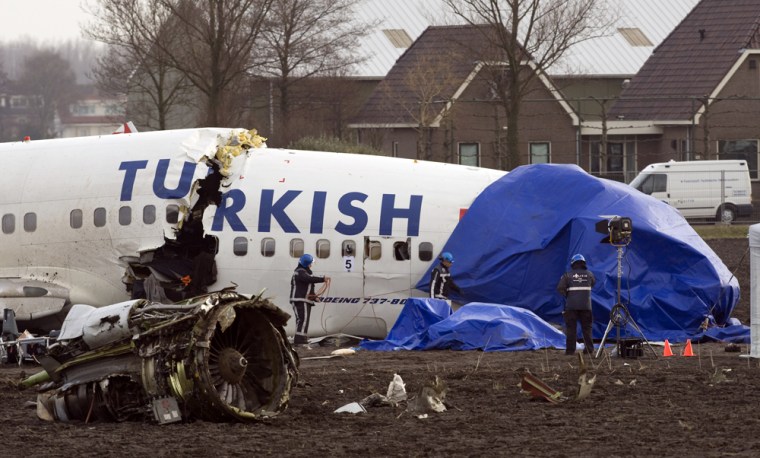Engine trouble may be behind the Turkish Airlines crash that killed nine people, including four Americans, in the Netherlands, the head of the agency investigating the accident said Thursday.
Pieter van Vollenhoven said in remarks cited by Dutch state television NOS that the plane had fallen almost directly from the sky, which suggests the plane's motors might have stalled.
He said a reason for that had not yet been established.
The Boeing Co. said Thursday that the U.S. State Department had confirmed that two of its employees were among the dead and a third was hurt, NBC affiliate King 5 in Seattle reported. The station said on its Web site that the company was awaiting word on the condition of a fourth employee.
On Wednesday, Boeing spokesman Jim Proulx identified the four employees as Ronald A. Richey, John Salman, Ricky E. Wilson and Michael T. Hemmer and said they were from the Puget Sound area of western Washington state.
Spokeswoman Sandra Groenendal of the Dutch Safety Authority confirmed that NOS reported van Vollenhoven's remarks about a possible cause accurately.
Van Vollenhoven said analysis of the plane's flight data recorders in Paris could be completed as early as Friday, but his agency would probably not make a preliminary finding until next week.
"We hope to have a firmer grip as soon as possible," he said, adding that the information retrieved from the recorders was of high quality.
Flight TK1951 from Istanbul fell out of the sky about two miles short of the runway at Amsterdam's Schiphol Airport on Wednesday morning, smashing into three pieces and spraying luggage and debris across a muddy farmer's field. It was carrying 135 passengers and crew, not 134 as previously believed, said Theo Weterings, mayor of Harlemmermeer.
The wreckage did not burn and dozens of people walked away with only minor injuries.
Weterings told reporters that 121 people in all were treated for injuries and six remained in critical condition. Another 25 were considered seriously hurt.
The dead were five Turks and four Americans, Weterings said. Their names were not immediately released.
Dutch authorities said most of the passengers were Turkish and Dutch nationals; others came from Germany, Taiwan, Finland, Bulgaria and Italy.
Fred Sanders, spokesman for the Dutch Safety Authority, said the flight's data recorders and voice tapes have been sent to Paris for analysis. He said that study would take several days.
Clambering in, out of wreckageInvestigators in white overalls and blue helmets clambered in and out of the wreckage Thursday while others inspected the remains of the plane's two engines.
Although both pilots died in the crash, other members of the crew, passengers and witnesses on the ground would be interviewed, Sanders said.
Investigators will explore a wide range of possible causes, ranging from weather-related factors to insufficient fuel, navigational errors, pilot fatigue or bird strikes. Sanders said a preliminary result may be made public soon, although the full report will not be ready for months.
Turkish Transport Minister Binali Yildirim said a Turkish team of experts had left for the Netherlands to assist in the investigation. He also paid tribute to the pilot for minimizing casualties by landing on the soft field.
"I would like to commemorate the pilot, who at the cost of his own life, ensured that human casualties were low," Yildirim said.
One survivor, Jihad Alariachi, said there was no warning from the cockpit to brace for landing before the ground loomed up through the mist and drizzle.
"We braked really hard, but that's normal in a landing. And then the nose went up. And then we bounced ... with the nose aloft" before the final impact, she said.
'Everything appeared normal' Witnesses on the ground said the plane dropped from about 300 feet.
A retired pilot who listened to a radio exchange between air traffic controllers and the aircraft shortly before the crash said he didn't hear anything unusual.

"Everything appeared normal," said Joe Mazzone, a former Delta Air Lines captain. "They were given clearance to descend to 7,000 feet."
The recording was posted by the Web site LiveATC.net, which captures air traffic exchanges by monitoring scanners near airports.
"Turkish 1951 descending from level 7-0," one of the pilots said as they neared the airport, referring to the plane's altitude.
"Turkish 1951 hello. Descend to 4-0. Speed is OK for ILS 1-8 right," the controller replied, clearing the airliner to an altitude of 4,000 feet, where it would intercept an electronic beam guiding the plane down to Runway 18 Right.
The controller then read out correct radio frequency for communicating with the airport's tower after landing.
"OK, thanks sir," the pilot said. There was no indication of any trouble from his voice.
Sanders said the exchange was part of the investigation.
Crash historyWeather at the airport at the time was cloudy with a slight drizzle.
Turkish Airlines chief Temel Kotil said the captain, Hasan Tahsin, was an experienced former air force pilot. Turkish officials said the plane was built in 2002 and last underwent thorough maintenance on Dec. 22.
It was the deadliest crash in the Netherlands since a vintage DC3 crashed in a shallow sea on Sept. 25, 1996, killing 32 people. The country's worst crash came on Oct. 4, 1992 when an El Al cargo Boeing 747 slammed into an apartment block near Schiphol killing 43 people in the plane and on the ground.
